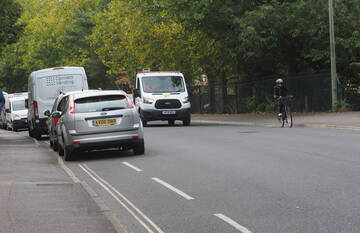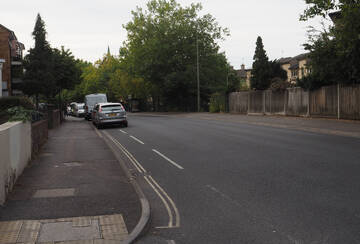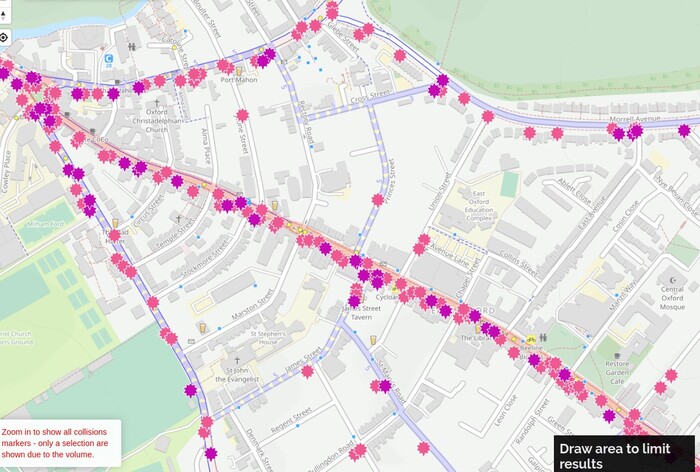Oxford's "Quickways" schemes may make cycling some trips faster for some people, but the biggest gains from them will be making cycling safer and more accessible. I will cycle some routes more slowly if these schemes are implemented!
So "Quickways" is a misnomer — "Saferways" would be much better. My previous post about these schemes focused on technical details. Here I want to focus on the basic road safety argument for them.
This map shows cycling collisions on some of the routes (purple is serious). The solution to this, as shown by Swedish Vision Zero and Dutch Sustainable Safety approaches, is to avoid mixing cycling with significant volumes of motor traffic, and the Quickways are a step towards that.
The Quickways schemes don't address the huge problems on the inner stretch of Cowley Rd, where they just have "20mph roundels refreshed", and they do little to improve the junctions, but in other places they will really improve safety.

the cycle lane runs straight into the parked cars
|

poor visibility of approaching traffic when turning right out of James St onto Iffley Rd
|
The left photo shows the cycle lane on Iffley Rd, just south of James St, which runs straight into a line of parked cars. This would be farcical if it wasn't so dangerous. People cycling are forced to merge with motor traffic here, at speed, with poor forward visibility. Then people have to cycle with dooring risk on one side and motor traffic passing too close on the other side. I cycle faster than is comfortable here, to minimise the time spent in such a hostile situation and because going faster means fewer drivers will insist on overtaking. Cycling here with a child doing 6mph is mostly just too horrible.
Those same parked cars also obscure the view of traffic for anyone trying to turn out of James St, as shown in the right-hand photo above. (Poor visibility is often overlooked as a concern, but it's a major contributor to collisions.)
On Morrell Avenue, a similar situation is exacerbated by the climb up the hill. Having to stop and restart makes that even more of a deterrent, and drivers are less likely to wait behind someone cycling at 5mph than at 10mph, so close passes are pretty much inevitable here. There's only room for a cycle lane in one direction here, even with the parking removed, but having an uphill cycle lane will be a huge improvement.
Warneford Lane is possibly the worst of the routes at the moment: the marked cycle lanes there are positively dangerous. Even well-parked cars can stick 20cm into the lane, and people cycling are supposed to stay a metre away from parked cars because of dooring risks. Which just doesn't add up! There is 6m of space in each direction on Warneford Lane, which will just fit 3m for motor traffic, a 0.5m buffer, and 2.5m for a cycle lane or for parking. There is no configuration here which will fit all three. The existing layout just shoves people cycling into the buffer between moving and parked cars. (The alternative solution for Morrell Avenue and Warneford Lane would be to put a bus gate onto Warneford Lane.
Parking
Now, onto removing all those 650 parking places... Yes, removing parking may cause some problems, but those in no way override the need to provide basic safety and accessibility for people cycling. The two areas that are likely to be most problematic for parking are Donnington, because it lacks a CPZ (it is now the closest area to Carfax without one), and the "EO" CPZ zone, which is probably under the most parking pressure. (Most of the parking on Warneford Lane is, anecdotally, used by Brookes students living in halls of residence, who are not supposed to have cars.)
The potential problem in Donnington should have been addressed by including it in the last round of CPZs - it had higher resident support than Florence Park or Temple Cowley, so I don't know why it was left out. Merging the EO and MN CPZs might help. But in the longer term the EO parking area may need a system like Amsterdam's, with permit numbers capped at a certain fraction of the available spaces and a waiting list for new permits. (Such a system could be deployed across Oxford and used to steadily reduce parking, as Amsterdam has been doing.)
To support disabled parking and loading and deliveries, and reduce the need for parking on the cycle lanes, the first parking places in each side street along main roads could be made into disabled and loading bays.


I read your missives and whilst they reiterate much which has already been written there is much I agree with.However like many correspondents you have not been able to give satisfactory solutions to some problems which will inevitably arise.
There is little doubt that the speed of motor traffic will increase on some cycle Quickways. For example on Morrell Avenue which is probably the most fully residential roads affected. This cannot make cycling safer .The current parking of cars on the road is the main factor slowing down vehicular traffic. Regarding the current 20MPH limit ,which is rarely enforced,you give no indication of how it could be. Lack of compliance might be inevitable but it’s degree could be reduced.
Like others you give no solution to essential parking. You simply say it’s a problem so essentially it’s tough luck for those who need it.This no doubt applies to those offering essential services like care workers, the disabled and those without off street parking. I wonder if you have the facility to park your car if you have one? One cannot fairly compare roads like Morrell Avenue to say the Woodstock Road.
Well done for learning late in life to ride a bike which is unquestionably a hazardous undertaking but one which is a lot safer in towns than in the countryside. It would be interesting to know what proportion of cycle accidents are the entire fault of the riders and don’t involve motor vehicles. Cyclists coming down Morrell Avenue for example at speeds above 20 MPH have certainly come unstuck due to lack of experience or stupidity whilst faulty and poorly maintained bikes have brought people off. I’m sure you are aware that many cyclists do not equip themselves with essential lights or high visibility gear and helmets and do not maintain there cycles in safe order so they are not completely innocent victims of accidents with vehicles.
I know residents of Morrell Avenue are concerned about the high possibility of damage to the verges and trees should people resort to parking on the verges. I would ask you to take this into consideration and make representation and forward ideas as how this can be prevented.
Thank you
MJK
Morrell Avenue is indeed a bit of an odd fish. It's being given Quickways treatment as if it were a main road, when it shouldn't be. The solution here is Connecting Oxford Plus, with a bus gate at the bottom of Morrell Avenue (or on St Clements, but in any case blocking through routes).
Removing the parking may increase speeds, but as well as providing an uphill cycle lane it will improve greatly visibility. The major risks for people cycling come from having to repeatedly merge and de-merge with motor traffic, and if they can proceed in a predictable straight line, where they're clearly visible to overtaking motor traffic from a distance, that will more than offset any increased risks from slightly faster traffic.
Double yellow lines prohibit parking as far as the property boundaries, so anyone parking on the verges can be fined - I don't think that will be a concern. Most of the houses on Morrell Avenue have off-street parking, so the residents here are better off than (say) those on Iffley Rd near Jackdaw Lane, where people are (as on pretty much every other main road in Oxford) going to have to park away from their houses.